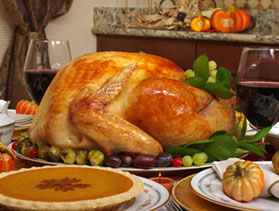



Keep your Thanksgiving free from foodborne illness
The US Department of Agriculture (USDA) offers tips on keeping foodborne illnesses off the menu
“Thanksgiving is one of my favorite times to remind people about food safety,” said Agriculture Secretary Tom Vilsack. “I personally know how much effort it takes to prepare a full Thanksgiving meal, and I always ensure I’m following safe food practices like handwashing, using a food thermometer and avoiding cross-contamination.”
By following the tips below, you’ll lessen the chances of having a visit from foodborne illness — an unwelcome visitor — at your table this Thanksgiving.
Clean and sanitize: Always wash your hands before preparing and handling food. Clean and sanitize any surfaces that will touch food such as tabletops, kitchen counters, stoves, sinks, etc.
Avoid cross-contamination: In a recent study, USDA found 60% of kitchen sinks were contaminated with germs after participants washed or rinsed poultry. USDA advises against washing your turkey; however, if you do wash your turkey in the sink, it must be fully cleaned and sanitized afterwards.
Thaw the turkey safely: Never thaw a turkey on a counter or in hot water. USDA recommends thawing a turkey in a refrigerator since this allows for slow and safe thawing. The turkey will need about 24 hours for every four to five pounds of turkey. If using the cold-water method, allow 30 minutes per pound and submerge the turkey in its original wrapping to avoid cross-contamination.
Cook thoroughly: Make sure your turkey reaches an internal temperature of 165 F. Use a food thermometer to measure the internal temperature in three parts: the thickest part of the breast, the innermost part of the wing and the innermost part of the thigh.
Stuffing your turkey: USDA does not recommend stuffing your turkey because it can be a breeding ground for bacteria if not prepared carefully. However, if you plan to stuff your turkey, please keep the following in mind:
- The wet and dry ingredients for the stuffing should be prepared separately from each other and refrigerated until ready to use.
- Stuff the turkey loosely — about 3/4 cup of stuffing per pound.
- Immediately place the stuffed, raw turkey in an oven set no lower than 325 F.
- A stuffed turkey will take longer to cook. Once it has finished cooking, place a food thermometer in the center of the stuffing to ensure it has reached a safe internal temperature of 165 F.
- Let the cooked turkey stand 20 minutes before removing the stuffing.
All perishable foods must be refrigerated within two hours of being cooked, or one hour if the temperature is 90 F or above.
After the meal (but within the two-hour rule), separate larger quantities of leftovers in small shallow containers and place them in the refrigerator. Thanksgiving leftovers are safely stored in a refrigerator for up to four days.









